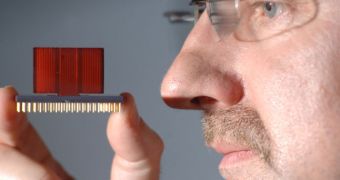Farmers around the world have been struggling for a full year to produce the most deliciously flavored foods and products, and also the best smelling ones. The smell of a tomato or a cucumber has been determined to be one of the most important factors people consider when buying their groceries, so there is a lot of competition between manufacturers going on in this field. Now, an electronic nose may make it easier for farmers to select the best products from their yearly harvests, AlphaGalileo reports
Until now, creating an artificial nose that is capable of identifying the most alluring flavors has proven to be very difficult, mostly because the electronic system needs to be able to identify the correct traits it needs to follow in a wide array of conditions. Other than the perfect settings inside a scientific laboratory, where everything is controlled, the real world is full of changing environmental conditions, for example. Devices need to be able to provide accurate results in conditions that keep changing hour after hour, day after day, around the entire year.
Now, scientists at the Universitat Jaume I's (UJI) Agro-Food Quality Improvement Group have managed to find a way of overcoming these fluctuations, by creating a statistical methodology of comparing the various traits a product has without mistake, and regardless of external conditions. UJI researcher Salvador Rosello explains one of the reasons behind the troublesome fluctuations by saying that, “The environment, laboratory temperature, humidity, and so on exert a significant influence, which means that to ensure the evaluations are useful an extensive amount of correction work has to have been carried out through a methodology that can be transferred to other teams and products.”
The main components in regular electronic noses, or smell detectors, are chemical sensors placed alongside a chemometric program that is able to recognize patterns in either simple or complex odors. While maintaining the overall aromatic impression, the new system is also capable of analyzing a large number of samples at the same time. Speaking about the available methods available to sample smells, Rosello says, “On the one hand, a tasting panel consisting of experts who provide information that is valuable, but which is of limited use and very expensive, as only a few tastings can be made each day. The other system involves chemical analysis, via a gas-mass spectrometer, which provides information on all the volatile compounds in a product so that you can compare between variables. However, this information is too abstract and the global evaluation is lost.”
“In an improvement program, if you want to select a specific variety, sometimes you have hundreds or thousands of samples, because you’re selecting a segregating generation, where there are quite different individuals, and what you really want is to select the best ones. This therefore completely rules out the use of a tasting panel. Analytic selection gives more information, but the overall impression is lost,” he adds. “In the case of tomatoes, there are more than 40 aromas involved but the number does not matter: the important thing is that as a whole they are perceived to be appropriate. Another advantage of using this equipment is that samples can be frozen and evaluated gradually so that in a period of some months, you may have evaluated significant numbers of samples,” he concludes.

 14 DAY TRIAL //
14 DAY TRIAL //